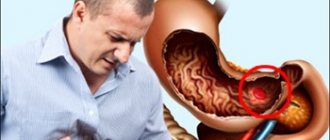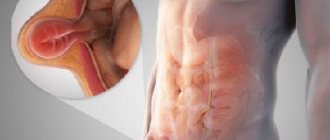Why do unpleasant symptoms occur?
Causes of nausea not related to illness include:
- Overeating and eating fatty foods . In this case, nausea appears after eating as a response of the body - it cannot cope with a “heavy” dish in terms of calories.
- Psychological factors. Constant stress, depression, and anxiety disrupt the overall metabolism in the body. Nausea occurs as soon as a person remembers an unpleasant experience or smells a familiar smell.
- Seasickness (motion sickness) . The receptors of the vestibular apparatus are irritated, a feeling of nausea occurs, which may be accompanied by vomiting.
- Pregnancy. Nausea and dizziness are observed in the first and second trimester of pregnancy. The sensation may progress to vomiting, but relief occurs on its own as the body adapts to pregnancy and the baby grows in the womb.
- In women, an unpleasant symptom often occurs during the premenstrual period.
- Impact of third party factors. An acute feeling of nausea can occur due to exposure to chemicals, medications, overheating, increased body temperature and other reasons.
Constant nausea often indicates the presence of various diseases. In some cases, depending on the stage of development of the disease, the feeling may occur periodically. He is called:
- Diseases that require urgent surgical intervention: appendicitis, acute pancreatitis, peritonitis of the gastrointestinal tract, intestinal obstruction.
- Chronic diseases associated with dysfunction of the gastrointestinal tract: peptic ulcer, cholecystitis, irritable bowel syndrome.
- Intestinal infections: enterovirus and rotavirus, cholecystitis, food poisoning.
- Liver diseases: hepatitis, cirrhosis.
- The presence of a foreign body in the abdomen (esophagus, intestines).
- Food allergies.
Severe headache and nausea can bother a person after traumatic brain injury, hypertension, diseases of the endocrine system, migraine, and after chemotherapy.
Nausea and vomiting with coronavirus
Severe complications and high mortality with COVID-19 force us to more carefully study the first symptoms of the disease. The difficulty lies in the fact that the virus rapidly mutates, and the clinical manifestations of the disease also change. In 2021, typical symptoms of coronavirus infection were fever, loss of smell and taste, muscle pain, and only then a cough. Only some patients experienced nausea and vomiting a little later. In 2021, the majority of cases are caused by the Indian strain of COVID-19, which is characterized by higher infectiousness and a “stomach” syndrome. Against the background of fever and catarrhal symptoms (runny nose, sore throat, cough), every third patient with coronavirus experiences nausea/vomiting and pain in the stomach. A little later, diarrhea and hearing problems appear, and the sense of smell disappears less often.
The "Delta" strain most often affects young people and children. And previously worked out treatment regimens give a noticeably less effect. This is why vaccination of the population, including those who have previously had coronavirus, is so important. Although a two-time vaccination does not completely eliminate infection, it will help avoid severe disease, complications and death. Among the sick, the percentage of vaccinated people does not exceed 1%.
Important! Nausea after vaccination against coronavirus occurs in every tenth vaccinated person. Vomiting is a rare side effect. All unpleasant consequences of the vaccine disappear within 3 days.
Clinical picture
Nausea, depending on the cause, may be accompanied by other symptoms.
- When eating fatty foods: abdominal pain, vomiting, weakness, drowsiness.
- Nausea is often observed in a child as a reaction of the body to an allergen. Adults and children equally experience: rash, redness, diarrhea, flatulence, runny nose, dry cough.
- In case of poisoning: flatulence, diarrhea, headaches, weakness.
In diseases, depending on the diagnosis, the manifestations differ:
- Diseases of the liver and gastrointestinal tract often resolve with vomiting, weakness, and body temperature rises to 39 degrees. There is a feeling of heaviness in the abdomen, diarrhea/constipation, and flatulence.
- Appendicitis will almost always be accompanied by acute pain in the lower abdomen and increased body temperature.
- With diseases of the cardiovascular system, nausea in the morning can turn into weakness in the afternoon, headaches, dizziness, and loss of consciousness.
Normally, in the absence of health problems, a person needs to eliminate the cause of the symptom. For example, exclude exposure to odors, consult a doctor about the need to take medications that calm the nervous system (if we are talking about psychological factors). Take a sorbent to remove toxins from the body in case of allergies or poisoning.
If, after treatment, pain, dizziness and nausea, as well as other accompanying symptoms, do not go away, you should urgently consult your doctor or gastroenterologist.
What to do if you feel sick in the morning
It is important to understand that regular morning sickness is a signal of the presence of a pathology or disease and self-medication is highly undesirable. Be sure to consult a doctor for an examination, but if you do not have such an opportunity at the moment, there are several effective ways that will help reduce or temporarily get rid of this problem:
- Medicines. You need to be very careful and you must be sure that morning sickness is not the cause of pregnancy or an intestinal disease.
- Drinks made from ginger root, mint and lemon. You can make infusions of these products for maximum effect by simply adding them to a glass and pouring boiling water, after 15 minutes you will have a very effective and safe (in the absence of allergies) remedy for morning sickness. YOU can also just add them to hot tea.
- Medicinal collection - if nausea persists in the morning, you can try a collection of mint, oak bark and celandine. To prepare the drink, take 1 teaspoon of mint leaves, dried oak bark and crushed celandine, pour 0.5 liters of boiling water and boil in a water bath for 10 minutes. After the broth is cooled and filtered, take 1 tbsp 3-5 times a day before meals.
- During pregnancy. There are little tricks you can use. For example, do not get out of bed quickly, drink plenty of fluids. Eliminate fatty and heavy foods from your diet. Eat small meals several times a day.
Treatment and diagnosis
If you are constantly bothered by nausea, a specialist will find out the causes of the symptom in several stages:
- Survey. Drawing up a detailed clinical picture allows the doctor to navigate further actions.
- Purpose of research. Depending on the circumstances under which the unpleasant feeling appeared, the doctor may prescribe: an ultrasound, a general blood test, a urine and stool test.
If the diagnostic results obtained show the absence of any diseases, the doctor will pay attention to the following points:
- whether a psychological disorder can be accompanied by nausea;
- whether relatives experienced similar symptoms;
- what foods the patient ate in the last 48 hours;
- How does this feeling affect the general condition of a person: do headaches and nausea occur along with it, are diarrhea, constipation, and flatulence bothering you.
Other causes of vomiting
- Myocardial infarction, arterial hypertension. With high blood pressure, vomiting is combined with a severe headache. During a heart attack, vomiting occurs simultaneously with severe chest pain.
- Diabetes mellitus in case of non-compliance with treatment regimens and diet. In this case, vomiting is combined with severe thirst and frequent urination. Severe vomiting in diabetes may be a sign of impending ketoacidosis.
- Kidney disease in the final stages (renal failure).
- Some medications may have the side effect of vomiting. If vomiting occurs during treatment with any drug, you should consult the doctor who prescribed the drug.
- Mental factors: stress, fear, anorexia, excitement, severe pain, individual unpleasant associations with any food, smell, taste, situation can also provoke nausea and vomiting. Recurrent vomiting may be a symptom of hysteria.
First aid
In the absence of chronic and current diseases, the doctor will prescribe treatment aimed at restoring the body. First of all, the patient will be advised to:
- Establish an enhanced drinking regime.
- Take anti-inflammatory and painkillers.
- In some cases, when it comes to severe forms of roto- or enterovirus, antibiotics are prescribed.
To remove toxins from the body, therapy may be accompanied by simultaneous intake of sorbents. The Sorbex series are safe enterosorbents that do not treat the disease, but can alleviate its symptoms and course. Their composition is based on granular activated carbon, which absorbs harmful substances and removes them from the body naturally. In the available line of products you can choose drugs for children and adults.
How to relieve nausea and vomiting at home
- Drink more fluids. The daily intake for adults is 30 ml/kg body weight. It is advisable to use decoctions of chamomile and mint. Drink slowly, in small sips. You should not drink only after bloody vomiting.
- Eat small meals. Food should be warm. Avoid hard, fried, spicy, fatty and sweet foods. But if you experience uncontrollable vomiting, you should refuse to eat.
- If an unconscious patient is vomiting, turn the head to the side to avoid aspiration.
- If you have severe nausea, you should lie down. Open windows for fresh air. Avoid strong odors and other irritants. Do not brush your teeth immediately after eating.
- If you suspect poisoning (vomiting and diarrhea), you can take activated carbon (1 tablet per 10 kg of weight), smecta, phosphalugel or polysorb.
- Measure your blood pressure. If the readings are high, take an antihypertensive drug prescribed by your doctor or call an ambulance.
- For low blood pressure, it is enough to drink a cup of tea or coffee and sniff ammonia.
- For motion sickness, it is permissible to take antihistamines or special medications (for example, Dramamine).
If nausea or vomiting continues for more than 2 days and your general condition is affected, you should consult a doctor. At the First Family Clinic of St. Petersburg, you will undergo all the necessary tests and instrumental studies in order to quickly identify the cause of the disease and prescribe effective treatment.
Literature used in writing
- "Gastroenterology - National Guide" (2008). Authors: Ivashkin V.T., Lapina T.L.
- “Diseases of the digestive system in pregnant women. Gastroenterology" (2011). Author: Eremina E.Yu.
- "Manual of Gastroenterology, Volume 1" (1995). Authors: Komarov F. I., Grebenev A. L.
- “Gastroesophageal reflux disease in children” (2007). Authors: Prokhorova L.I., Davydova A.N.
- “Inflammatory bowel diseases” (a practical guide for doctors, 2012). Author: Sitkin S.
Useful tips
If you are worried about nausea and vomiting, weakness, here are some useful recommendations that will help alleviate the condition:
- Abundant air flow - you can open a window or sit in front of a fan.
- Drinking fluids. Drink more water, it will also help prevent dehydration and speed up your metabolism.
- Compress. The feeling of nausea will go away if you apply a cold compress to the forehead and neck area.
- Do not lie down, the bitterness in your mouth and nausea will intensify - gastric juice may rise up the esophagus. This is why gastroenterologists do not advise “resting” after eating.
It is recommended to drink at least 1 glass of warm water every morning on an empty stomach. The liquid will “wake up” the gastrointestinal tract and normalize metabolism. Also follows:
- minimize the amount of “heavy” food in the diet;
- exclude carbonated drinks;
- take care of the cleanliness of products that do not require heat treatment (berries, vegetables, fruits).
As a sorbent for quick relief of abdominal pain, if nausea and vomiting occur due to poisoning and allergies, always have supplements in the form of Sorbex enterosorbent in your medicine cabinet.
SORBEX® Duo
SORBEX® Classic
SORBEX® Ultra
Medicines and dietary supplements of the Sorbex series (Sorbex, Sorbex Ultra, Sorbex DUO) are based on improved activated carbon. Thanks to modern production technologies, the sorption capacity of Sorbex® has been significantly increased, which ensures its high sorption ability to absorb toxins, bacteria and other harmful substances.
Sorbex capsules contain activated carbon in the form of granules, which ensures adsorption activity throughout the entire residence time of the sorbent in the gastrointestinal tract. The effectiveness of granular carbon almost does not decrease within 36-48 hours, which allows you to increase the intervals between doses of this drug and reduce the dose. For adults with chronic diseases caused by endogenous intoxications, it is recommended to take 2–6 capsules 3 times a day for 10–15 days. For children over 7 years old, take 1-3 capsules 3-4 times a day. The drug is administered orally with water at intervals of 1.5–2 hours before or after meals or medications.
SORBEX ULTRA is a dietary supplement in the form of capsules based on highly dispersed activated carbon with extremely high adsorption activity, therefore it is especially effective for acute poisoning. Adults are recommended to take 1 capsule 2-3 times a day.
SORBEX DUO is a dietary supplement for the comprehensive cleansing of toxins from the body, combining the unique properties of a hydrocarbon sorbent in the form of granules and milk thistle extract. Thanks to this composition, SORBEX DUO helps reduce the manifestations of intoxication, protects and restores liver function. Adults take 2-3 capsules 2-3 times a day. Children aged 7 years and older – 1 capsule 2-3 times a day before or 1-1.5 hours after meals. Duration of use from 3 to 15 days
It should be borne in mind that sometimes nausea may be the only early sign of serious illness, so this symptom should not be ignored and you should consult a doctor.
Attention! Self-medication can harm your health!
Types and causes of occurrence
Nausea does not occur without a reason. Among the main provoking factors, overeating, nervous tension, side effects when taking certain medications, hormonal disorders, hyperthermia and diseases of the digestive system should be noted. Based on practice, many visits to a specialist regarding constant nausea are associated with the latent course of cholecystitis, gastrointestinal ulcers, gastritis, pancreatitis, intestinal obstruction and individual intolerance to certain foods, colitis, Crohn's disease, hepatitis, liver failure, biliary dyskinesia, etc. .
What does the nature of vomiting indicate?
In all cases of vomiting, it is necessary to pay attention to the nature of the vomit:
- Vomiting blood
may indicate bleeding from a stomach or duodenal ulcer and is an indication for emergency treatment. Sometimes a person may not know that he has a peptic ulcer and the first symptom will be bleeding. In addition, vomiting blood occurs when bleeding from dilated veins of the esophagus in people with cirrhosis of the liver. - Vomiting blood mixed with foam most often indicates pulmonary hemorrhage.
- Vomit that is yellow or green in color and has a bitter taste indicates that it is bile. Vomiting bile indicates liver disease, gall bladder and often occurs after eating fatty foods.
Attention! In all cases of vomiting with blood (fresh or dark), the patient should be immediately shown to a doctor!








